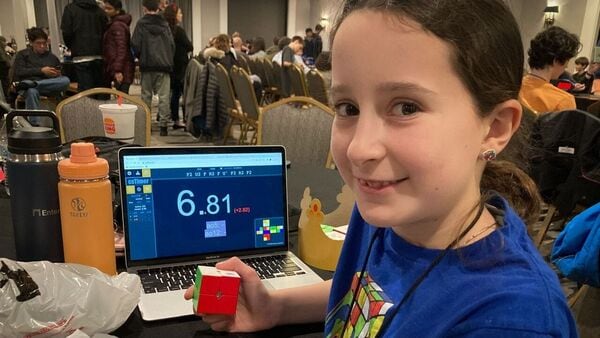As the Rubik’s Cube turns 50, a revolution looms

Summary
The world of speed cubing is moving fast. But who will decide the next turn?NEW YORK—For die-hard fans of the Rubik’s Cube, it isn’t about whether you can crack the iconic puzzle. It’s about how fast.
In a bustling hotel ballroom in Queens, some 90 competitors are practicing or locked in a speed-cubing showdown, racing to match all sides of the three-dimensional puzzle.
Over a loudspeaker, event organizers summon participants to join one of six tables for a round. When the scrambled cube appears, players have 15 seconds to scrutinize it, turning it this way and that to plot out a flurry of rotations. The fastest solve took teen whiz Jerry Yao just 5.5 seconds.
After a ceremony honoring the winners, Yao playfully boasted in response to questions from a reporter. “If my friends are listening, I’m like, I’m a lot better than all of them," he said. “And I want to like, keep it that way."
Speed-cubing culture often fosters self-improvement and friendships. But as Yao’s intensity suggests, a shift rumbles through this world. Cubers keep shaving milliseconds off records, and some insiders dream of bright lights and roaring spectators.
There is talk about “how cubing and speed cubing can evolve…and make it more of a spectacle, more entertaining," says Sam Susz, a brand marketing executive at Spin Master, the Canadian toy company that acquired Rubik’s Cube in 2020 for $50 million. He mentions the potential for a World Cup, or an Olympics exhibition.
Humble start
Speed cubing’s origins didn’t lack showmanship. In 1982, at the first official Rubik’s Cube World Championship in Budapest, the winner’s check “was physically big to show to the cameras," the puzzle’s Hungarian inventor Ernő Rubik later wrote. He created his cube in 1974.
Despite millions of cubes being sold worldwide in the early ‘80s, interest fizzled. But in the early 2000s, with wider internet adoption, cube enthusiasts compared their times in an online community hosted by Yahoo called “Speedsolving Rubik’s Cube Group."
The rules were standardized in 2004 by the World Cube Association, a nonprofit co-founded by Ron van Bruchem, a Dutch IT worker who says he coined the term “speed cubing." The WCA now organizes hundreds of events yearly around the world—including the recent one in Queens—fueled by volunteers and small competitor fees. Last year, more than 60,000 cubers participated in at least one competition, up roughly sixfold from a decade ago, according to the organization.
“You have to organize competitions. That’s the most important thing," van Bruchem says. “I personally try to do that as low budget as possible, because the experience is more important than how glossy it looks or whatever."
Some disagree.
By nearly everyone’s account, speed cubing is growing, and that means opportunity. Susz, of Spin Master, appreciates WCA’s massive engagement. But he says head-to-head competitions, rather than time trials, could attract viewers.
“I’m more aligned with Spin Master on that," says Cameron Brown, the founder and CEO of SpeedCubeShop, which sells cubes manufactured in China—not official brands.
The company’s own 2022 Las Vegas event “was very different to what your typical Rubik’s Cube competition is," says Brown.
Competitors faced off by skill level, without the WCA-standard 15 seconds to inspect their cube. “The nerves kind of come out," he says. “It could so easily be more televisable, like, you know, esports and ping pong and things like that."
TheCubicle, another speed cube retailer, sponsors the Monkey League, which pits top speed cubers against each other. It’s by invitation only.
“It’s extremely pro-oriented," says CEO Phil Yu. “I’m faster than 99% of the speed cubers in the world and I would lose 100% of my races in the Monkey League."
Cubers keep breaking speed records for the standard shape, but also two-by-two, five-by-five and seven-by-seven cubes. And participants have gotten “younger and younger," says Eric Zhao, an organizer at the Queens event.
Max Park, a 22-year-old American, holds the current world record: solving a cube in 3.13 seconds last year. But it isn’t just more competition making speed cubing faster—the hardware itself is evolving.
Cameron Brown points to the introduction of internal magnets around 2017 as a crucial development. “It kind of helps complete the turn and lock the layer into place," he says, calling today’s cubing technology “mind-boggling." (Brown’s company even sells cube lubricant for smoother performance).
Sponsorships, signaling big-league status, are afoot. Schwan Park, Max’s father, imagines a future where some competitors might “be Tiger Woods and make millions." Max has already done a Frontier Fiber commercial, and partnered with the sports-drink brand Prime.
Max Park also co-hosted a “cube camp" this month in his native Cerritos, Calif., where Phil Yu gave a seminar on “the intricacies and essentials" of securing a sponsorship with major speed cube manufacturers.
‘Cubing friend group’
The Queens competition offers a gentle introduction to speed cubing—though of course everyone here can solve a cube, and pretty quickly.
Jeffrey Castaneda, who works in public relations for Samsung, accompanied his son Aaron, 12, to the event. Aaron and three other kids, who attend different schools, say their “cubing friend group" formed at competitions. “It felt like they found their tribe once they started, you know, competing and playing with each other," Castaneda says from the sidelines.
Girls are in the minority. “I’d just love for there to be more," adds Rafa Gabinete, 14. “The community is also, like, really nice and you just get to meet so many, like, new people and friends."
Daniel Wiginton, a pastor, drove his two sons from Matawan, N.J. “They both made fun of me because I couldn’t solve a cube," he says. “So I learned to solve it, and now they make fun of me because I’m slow."
Write to Pierre Bienaimé at pierre.bienaime@wsj.com






